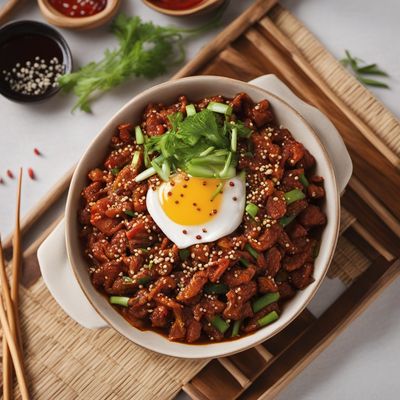
Recipe
Jeungpyeon - Burundian Style
Fluffy Rice Cakes with a Burundian Twist
4.7 out of 5
Indulge in the delightful flavors of Burundi with this unique adaptation of Jeungpyeon, a traditional Korean dish. These fluffy rice cakes, infused with Burundian spices, will transport you to the heart of East Africa.
Metadata
Preparation time
15 minutes
Cooking time
30 minutes
Total time
2 hours 45 minutes
Yields
4 servings
Preparation difficulty
Easy
Suitable for
Vegetarian, Vegan, Gluten-free, Dairy-free, Nut-free
Allergens
N/A
Not suitable for
Paleo, Keto, Low-carb, High-protein, Atkins
Ingredients
In this adaptation, the original Korean Jeungpyeon is transformed into a Burundian delight by incorporating Burundian spices and using a combination of rice flour and millet flour instead of just rice flour. The addition of Burundian spices adds a unique flavor profile to the dish, while the use of millet flour enhances the texture and taste of the rice cakes. We alse have the original recipe for Jeungpyeon, so you can check it out.
-
2 cups (400g) rice flour 2 cups (400g) rice flour
-
1 cup (200g) millet flour 1 cup (200g) millet flour
-
1 tablespoon sugar 1 tablespoon sugar
-
1 teaspoon salt 1 teaspoon salt
-
1 teaspoon active dry yeast 1 teaspoon active dry yeast
-
1 teaspoon ground coriander 1 teaspoon ground coriander
-
1/2 teaspoon ground cumin 1/2 teaspoon ground cumin
-
1/2 teaspoon ground cardamom 1/2 teaspoon ground cardamom
-
1 1/2 cups (355ml) warm water 1 1/2 cups (355ml) warm water
-
Vegetable oil, for greasing Vegetable oil, for greasing
Nutrition
- Calories (kcal / KJ): 250 kcal / 1046 KJ
- Fat (total, saturated): 1g, 0g
- Carbohydrates (total, sugars): 55g, 1g
- Protein: 5g
- Fiber: 2g
- Salt: 1g
Preparation
-
1.In a large mixing bowl, combine the rice flour, millet flour, sugar, salt, yeast, ground coriander, ground cumin, and ground cardamom.
-
2.Gradually add warm water to the dry ingredients while stirring continuously until a smooth batter is formed.
-
3.Cover the bowl with a clean kitchen towel and let the batter rest in a warm place for about 2 hours, allowing it to ferment and rise.
-
4.Grease a steamer basket or a heatproof dish with vegetable oil.
-
5.Pour the fermented batter into the greased steamer basket or dish, filling it about 2/3 full.
-
6.Place the steamer basket or dish in a large pot filled with water, making sure the water level is below the steamer.
-
7.Cover the pot with a lid and steam the rice cake batter over medium heat for approximately 30 minutes, or until a toothpick inserted into the center comes out clean.
-
8.Once cooked, remove the steamer basket or dish from the pot and let it cool for a few minutes.
-
9.Cut the steamed rice cake into desired shapes and serve warm.
Treat your ingredients with care...
- Rice flour — Make sure to use finely ground rice flour for the best texture in the rice cakes.
- Millet flour — If millet flour is not available, you can substitute it with cornmeal or sorghum flour for a similar nutty flavor.
- Active dry yeast — Ensure that the yeast is fresh and active to allow proper fermentation of the batter.
Tips & Tricks
- For added flavor, you can sprinkle sesame seeds or chopped fresh herbs on top of the rice cakes before steaming.
- Serve the Burundian-style Jeungpyeon with a side of spicy tomato chutney for a burst of tangy flavor.
- If you prefer a sweeter version, you can drizzle the rice cakes with honey or maple syrup before serving.
- Leftover rice cakes can be stored in an airtight container in the refrigerator for up to 3 days. Reheat them in a steamer or microwave before serving.
- Experiment with different spices and herbs to create your own unique variations of Burundian-style Jeungpyeon.
Serving advice
Serve the Burundian-style Jeungpyeon as a delightful snack or appetizer. They can be enjoyed on their own or paired with a spicy tomato chutney for a burst of flavor. These fluffy rice cakes are best served warm.
Presentation advice
Arrange the Burundian-style Jeungpyeon on a platter, garnished with fresh herbs or sesame seeds for an appealing presentation. You can also serve them in individual bamboo steamers for an authentic touch.
More recipes...
For Jeungpyeon
For Korean cuisine » Browse all
More Korean cuisine dishes » Browse all

Hanjeongsal
Hanjeongsal (pork dish)
Hanjeongsal is a Korean dish made with grilled pork jowl.

Dubujeon
Dubujeon, or Korean pancake, is a savory dish that is perfect for breakfast, lunch, or dinner. The dish is simple to prepare and can be customized...

Godeungeo gui
Grilled Mackerel
Godeungeo gui is a traditional Korean dish that features grilled mackerel with a flavorful soy sauce and garlic marinade. This dish is perfect for...








